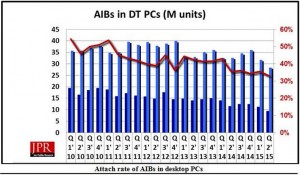New market report from Jon Peddie Research says Nvidia gained market share at the expense of AMD.
Jon Peddie Research (JPR), the industry’s research and consulting firm for graphics and multimedia, announced estimated PC graphics add-in-board (AIB) shipments and suppliers’ market share for the second quarter of 2015.
The news was discouraging and seasonally understandable, quarter-to-quarter, the AIB market decreased 16.81% (compared to the desktop PC market, which decreased 14.77%). On a year-to-year basis, we found that total AIB shipments during the quarter fell 18.77%, which is more than desktop PCs, which fell 6.52%.

JPR’s AIB Report tracks computer add-in graphics boards, which carry discrete graphics chips. AIBs used in desktop PCs, workstations, servers, and other devices such as scientific instruments. They are sold directly to customers as aftermarket products, or are factory installed. In all cases, AIBs represent the higher end of the graphics industry using discrete chips and private high-speed memory, as compared to the integrated GPUs in CPUs that share slower system memory.
The quarter in general
In spite of the overall decline, somewhat due to tablets and embedded graphics, PC gaming continues to build momentum and is the bright spot in the AIB market.
The overall PC desktop market increased quarter-to-quarter including double-attach (the adding of a second or third AIB to a system) with integrated processor graphics and to a lesser extent dual AIBs in performance desktop machines using either AMD’s Crossfire or Nvidia’s SLI technology.
The attach rate of AIBs to desktop PCs has declined from a high of 63% in Q1 2008 to 37% this quarter. JPR found that AIB shipments during the quarter behaved according to past years with regard to seasonality, but the increase was less than the 10-year average. AIB shipments decreased 16.81% from the last quarter (the 10-year average is 8.7% ).
Total AIB shipments decreased this quarter to 9.4 million units from last quarter.
AMD’s quarter-to-quarter total desktop AIB unit shipments decreased 33.3%. Nvidia’s quarter-to-quarter unit shipments decreased 12.0% Nvidia continues to hold a dominant market share position at 81.9%.
Figures for the other suppliers were flat to declining.
The change from year to year decreased 18.8% compared to last year.
This quarter compared to quarter-to-quarter percentage changes for the vendors are shown in Table 1.

The AIB market has benefited from the enthusiast segment PC growth, which has been partially fueled by recent introductions of exciting new powerful boards.
The demand for high-end PCs and associated hardware from the enthusiast and overclocking segments has bucked the downward trend and given AIB vendors a needed prospect to offset declining sales in the mainstream consumer space.
An example of this consequence helping to push up prices for suppliers’ product lines was Nvidia’s introduction of the GeForce GTX Titan X in March. Offered at the shocking price of $999, the Titan set a new level for the most expensive single-GPU AIB.
That had a halo effect on Nvidia’s other AIBs and when the GeForce GTX 980 Ti was introduced in June, it was considered as having a price-performance ratio justifying its relatively high price of $649, and it sold very well.
New “gaming” monitors were introduced by Acer, LG, and others with wide formats, screen resolutions of 2560 x 1440, and reasonable prices in the sub $400 range. Such offerings will help stimulate the demand for new AIBs in Q3.
In the years we have been tracking the market, we have seen AIBs evolve from un-programmable graphics controllers with 256 KB, to GPUs, to dual GPUs, and 12 MB AIBs that could be overclocked and water-cooled. Those improvements in performance, and the value for money and AIB represents, have been driven by the demand for more and more by the high-end enthusiast gamer, and the rest of the industry has benefited.
The AIB market now has just four chip (GPU) suppliers, who also build and sell AIBs. The primary suppliers of GPUs are AMD and Nvidia. There are 48 AIB suppliers, the AIB OEM customers of the GPU suppliers, which they call “partners.”
In addition to privately branded AIBs offered worldwide, about a dozen PC suppliers offer AIBs as part of a system, and/or as an option, and some that offer AIBs as separate aftermarket products.
Click here to learn more about this major report, or to download it now.





